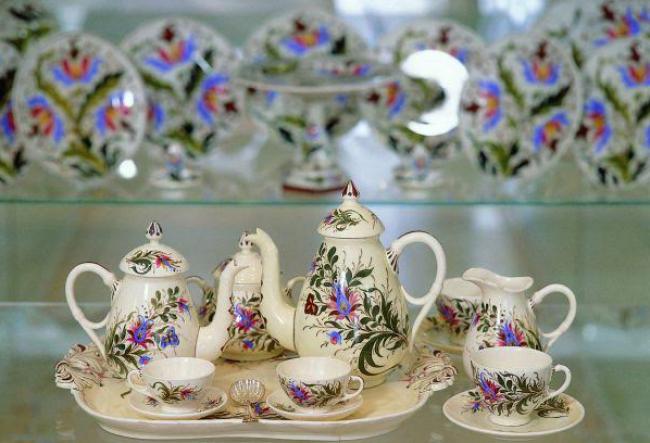05 Nov 2015, 09:05 am

Imagine a story of a king with two daughters. One was married within the region while a different story awaiting the other. Suppose one day a prince of a different country arrive and fall in love with the other princess, marry her and take her to his kingdom far away. There they lived happily ever. This in a nutshell is the story of porcelain’s journey to Europe from China. Though it had originated in China at the time of the Tang Dynasty (618-907), with Marco Polo it travelled to Italy in 1295 and later became part of Europe’s craftsmanship.
Edmund de Waal, who has worked with porcelain for 25 years, just recently come out with his book The White Road tracing the journey of the magical clay with his memoirs and anecdotes, making it more than just tracing a history. He says: “It’s really quite simple, a pilgrimage of sorts, to beginnings, a chance to walk up the mountain where the white earth comes from …I have a plan to go to three places where porcelain was invented, or reinvented, three white hills in China and Germany and England.”.jpg)
The writer travels from China to Dresden and Cornwall after beginning his journey in Jingdezhen in south-eastern China, known to be the porcelain capital of the ancient times.
According to the book quoted by New Statesman, the process, kept secret for centuries, begins with the mining of two substances – petuntse, or porcelain stone, and kaolin, or porcelain clay.
"First, they are dug from the earth and then they are purified, mixed, shaped, glazed and fired. It was an industry that once involved thousands of different labourers and thousands of now half-extinct skills and techniques, among them 'six categories of decorator, three of specialists in packing kilns, three for firing kilns, mould-makers, carpenters for crates, basket-makers, ash men . . .”
Journey of porcelain in Europe’s Austria started with Claudius Innocentius du Paquier who in 1718 was the founder of the second porcelain manufactory in Europe in Vienna.
It was called Augarten porcelain and the manufactory in Vienna was set up after Augustus II, King of Poland, founded the first European hard paste porcelain factory at Meissen in 1710 (in Germany).
Augarten pieces bear the shield from the coat of arms of the Dukes of Austria as a trademark. Austrian connection with porcelain developed further with Duke Alexander of Lorraine’s porcelain collection from far east around 1700, which are in display at Hofburg Place in Vienna. It then peaked with tableware collection of Empress Maria Theresa in the mid 18th century.
Some of the surviving pieces of Duke Alexander of Lorraine represent an interesting symbiosis between Far Eastern and European culture. European silversmiths created a unique combination of silver and gold with porcelain from Japan and China. Their blue, red and gold painted decoration is in the typical colours of Japanese porcelain of that epoch, which is known as Imari ware.
“Tambours” or bronze-gilt stands which held sweetmeats and decorated the imperial dining table; belongs to the New French Centre piece acquired by the young Emperor Franz Joseph.
In 1803 Emperor Franz of Austria ordered a porcelain service comprising 120 items for the court table, including 60 pictorial plates for dessert and 24 “panorama” soup plates of exceptional quality.
The choice of motifs was both patriotic and Romantic. Framed by gold rims, the scenes include erupting volcanoes, icy glacier landscapes or imposing Viennese architecture – with each plate displaying three views from Austria, Switzerland and Italy, executed by the best porcelain painters after old engravings, a painstaking task that took five years
This white and gold dinner service was acquired for EmperorFerdinand in 1851. Ferdinand, abdicated from the throne during the course of thebourgeois revolution of 1848 and subsequently moved to Prague,where he lived until his death.The white and gold dinner service was ordered for his household in Prague from the porcelain manufactory of the Countsof Thun at Klösterle in Bohemia.
The design was the very height of fashion at that time. Tastes had changed around the middle of the 19th century, with the emphatically clear lines of the Biedermeier era giving way to asofter, more flowing formal idiom. The rich gold decoration expresses the growing need to demonstrate feudal magnificence, a tendency that also made itself felt at the imperial Viennese court.
Another magnificent service with the green ribbons was a precious gift as a sign of increasing rapprochement between France and Austria after the bloody wars of succession; from the French king, Louis XV, to Empress Maria Theresa. Green intertwining ribbons represent the main decorative element, between the ribbons are delicately ornamented representing love, poetry, music, painting and sculpture.
This elegant wares were produced by the royal French porcelain manufactory at Sèvres (France), which was founded in 1738. They are made of a special porcelain known as “frit”, which, while more fragile, allows the colours to develop a particularly intense radiance due to the lower firing temperature.
There was a tradition that every archduke of Habsburg family had to learn a manual craft or trade. The Vienna Porcelain Manufactory was commissioned to produce two series of floral plates dedicated to Emperor Franz II/I (1768-1835) who had learned gardening and loved flowers. These plates were used as dessert.
.jpg) The first porcelain manufactory in Europe was established at Meissen in Germany around 1710. Meissen china is the first European hard-paste porcelain developed from 1708 by Ehrenfried Walther von Tschirnhaus, a German mathematician, physicist, physician, and philosopher considered to have been the inventor of European porcelain.T
The first porcelain manufactory in Europe was established at Meissen in Germany around 1710. Meissen china is the first European hard-paste porcelain developed from 1708 by Ehrenfried Walther von Tschirnhaus, a German mathematician, physicist, physician, and philosopher considered to have been the inventor of European porcelain.T
his Meissen service made around 1775 is striking for its exquisite floral painting. The shapes of the individual pieces are good examples of “Baroque Classicism”. The perforated fruit basket already displays elements of Classicism with its predilection for the formal repertoire of Antiquity.
A remarkable exhibit here is the unusual English dinner service that Empress Elisabeth gave to Emperor Franz Joseph for his hunting lodge at Offensee. Dating to 1870, it was designed by WilliamColeman and is decorated with naturalistic representations of insects, birds, sea creatures and plants.
The Palace was without bathroom till Empress Elisabeth had her own bathroom installed in 1876. Even after this, most of the court house hold had to make do with sets of sanitary porcelain consisting of washbasins, water jugs, footbaths, shaving bowls, soap dishes, chamber pots and so on. Most of them were made of white porcelain and decorated with a gold rim and a gold imperial eagle.
The manufactory dropped out from business in 1864. The porcelain of the Vienna manufactory are often referred to as "Alt Wien" (Old Vienna) porcelain, to distinguish it from the products of the new Ausgarten manufactory, which was established in 1923, and revived the traditions of the old Vienna porcelain manufactory.
Modern designers such as Josef Hoffmann, Walter Bosse and Hertha Bucher characterized production in the 1920s and 1930s. The preference for clarifying simplicity that prevailed in the 1950s is on display, as are works by Arik Brauer from the 1970s.
AlbinDenk is another name which can’t be avoided when depicting Viennese porcelain. It was founded in 1702 as the first porcelain house in the city center of Vienna and awarded with the title of imperial purveyors in 1878.
Eventually, they collaborated with internationally renowned and traditional suppliers over the years. They selecttheir products, on the basis of standards and more over emphasize on traditional manufacturing innovative, high quality products and brands.
- From Kennedy’s Proposal to 1850s Saloons: The Three Historic D.C. Restaurants Everyone Must Try
- This city has the best bagel in the US, and it’s not New York!
- I escaped to Pachmarhi — what I found in the queen of Satpura left me spellbound
- Air Canada just ranked the Best New Restaurants of 2025 - And the Top Spot isn't who you think
- Rediscovering Arunachal's Monpa Cuisine: One Woman’s Millet Momo Revolution
- Discovering Heritage: A visual journey through Odisha crafts museum Kalabhoomi
- From kebabs to biriyani: Lucknow gets UNESCO honour for its royal cuisine
- Delta takes Spanish flavours to the skies
- Kolkata’s iconic Kathi Roll among world’s top 10 wraps: TasteAtlas
- Yellow Taxis and the Colours of Puja
Air Canada has introduced a new non-stop route connecting Toronto with Rio de Janeiro, with the first flight landing in the Brazilian city on Friday morning.
Air India, India’s leading global airline, and Maldivian, the national airline of the Maldives, have entered a bilateral interline partnership aimed at boosting connectivity between the two countries.
IndiGo, India’s largest airline, is grappling with one of its most severe operational crises in recent years, with widespread flight delays and cancellations disrupting travel across the country for a second consecutive day.





